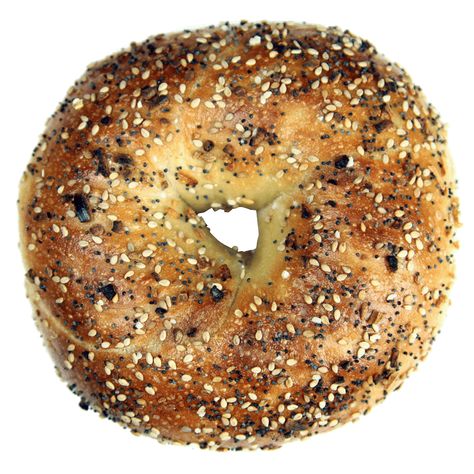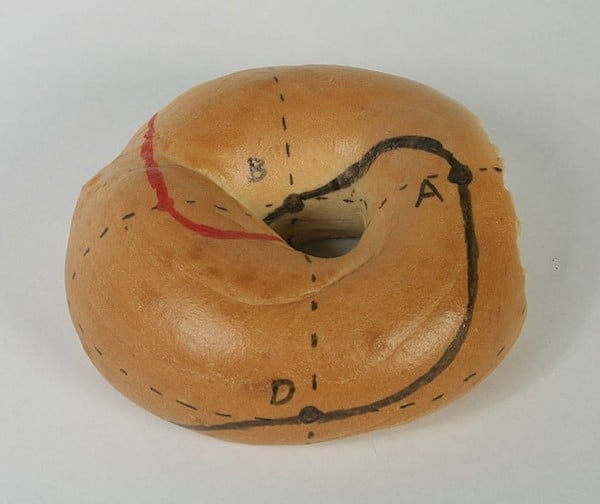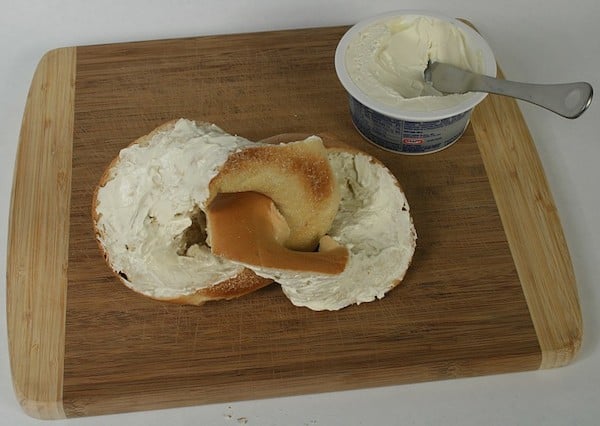kottke.org posts about bagels

Dan Nosowitz digs into the genealogies of bagel-making to find and define the true (i.e., disputed) origin of the everything bagel.
Let’s be honest, it’s probably not possible to have “invented” the concept of putting several different existing bagel toppings on a bagel. In patent law there is something called the rule of “obviousness,” a tricky concept, but one that’s both necessary and necessarily subjective. It states that something cannot be patented if a person with ordinary skill in a subject would naturally use the same idea to solve a problem. A painter, for example, cannot patent a jar of water for cleaning brushes, because any painter, understanding that water is used to clean brushes and that a jar is a good vessel to hold water, would come to the same conclusion. Or, for example, if there are five popular bagel toppings, it is fairly obvious to make a bagel with all of those ingredients. That’s not invention.
But there is one element of the everything bagel that is invention, and that’s the name. “Everything” is the accepted name for a fairly specific combination of toppings: It is not a “combo bagel” or a “spice-lover’s bagel” or, as the Canadians might call it, an “all-dressed bagel.” It is an everything bagel, and someone had to come up with that piece of clear, descriptive branding.
By his own and most other accounts, that person was David Gussin. Around 1979 or 1980, he says, he was a teenager working at Charlie’s Bagels in the Howard Beach neighborhood of Queens, New York. “It didn’t actually say ‘Charlie’s Bagels,’ it just said ‘Bagels,’ but it was Charlie’s,” says Gussin. He was doing typical teenage job stuff: cleaning, working the counter—and cleaning the oven, where excess bagel toppings accumulated when they fell off. “One day instead of throwing them out like I usually did, I gave them to Charlie and said, ‘Hey, make a bagel with these, we’ll call it the everything bagel.’ It wasn’t that big of a deal; we weren’t looking to make the next big bagel. Charlie was probably more interested in what horses he was going to bet on.”
What’s weird, as Nosowitz notices, is that the everything bagel doesn’t include everything. An everything bagel with sunflower seeds is a mistake. “Everything” is sesame, onion, garlic, poppy, and salt. And it’s called “everything.” This is what’s invented, what is non-obvious. It is merely true.
Murray’s Bagels in New York will now toast customers’ bagels on request, doubtlessly reviving a debate about the appropriateness thereof that rivals the oxford comma, shorts on men, and the pronunciation of GIF in its ferocity over the smallest things.
To this I say, let a million flowers bloom, à chacun son goût, de gustibus non est disputandum, whatever blows your hair back. Judge not your fellow citizens’ bagel choices, whether in flavor, condiment, or the preparation thereof. But customers, you too should not judge your bagelry too harshly if they are not able to toast your bagel to your specifications. Your indignation is as unwelcome as the prejudice against you.
After all, those machines take up a lot of counter space. And you’re holding up the line.
What if you wanted to cut a bagel in half not for toasting or sandwich purposes, but to explore its topology and mildly astonish your friends?

If you cut a bagel along a möbius strip pattern, you end up with two separate halves that form interlocking rings, as shown below.

Geoge Hart, who cut this bagel and made this video, is an engineering professor at SUNY-Stony Brook and “mathematical sculptor. On his web site, he offers two bagel-derived math problems: What is the ratio of the surface area of this linked cut to the surface area of the usual planar bagel slice? and Modify the cut so the cutting surface is a one-twist Mobius strip.
Via @mark_e_evans and The Onion A/V Club.
Murray Lender, the man behind the company credited with introducing most Americans to bagels has passed away. Lender, born in 1930, helped turn his father’s Connecticut bakery into a national bagel powerhouse, turning out 2.75 million Lender’s Bagels a day, while never forgetting his roots. A Connecticut friend mentioned Lender’s used to drop off green bagels for school children on St Patrick’s Day.
For you bagel purists, Murray told the AP in 1986, “Taste is a very subjective matter. It’s clear and simple: We make 2 3/4 million bagels a day. Obviously an awful lot of people are happy with it.” Coincidentally, Consumer Reports’ May issue features a bagel breakdown which honors Lender’s Bagels as one of the best. This has not gone over well in New York.
Regardless of your feelings on Lender’s Bagels, we probably wouldn’t even be having the bagel argument without Murray Lender.
(via djacobs)
If I didn’t know any better, I’d have thought Twitter was built specifically for the purpose of cracking wise about the lack of everything on the everything bagel. In recent months, several tweetists have taken to site to complain in often amusing fashion:
Come on, Everything Bagels, who you tryin’ to fool? You got like 6 seasonings on there. That’s a lot, but it ain’t everything.
— @patrickmarkryan
Hey everything bagel, you don’t have everything on you, so shut the fuck up.
— @ihatejeffbaker
This “everything bagel” is great. Has onions, poppy seeds, garlic, cheese, q-tips, Greenland, fear, sandals, wolves, teapots, crunking…
— @johnmoe
You call this an everything bagel?! Where are the french fries & the pizza & the pot brownie & the Taco Bell fire sauce?!
— @ronniewk
Flossing after an everything bagel is important b/c as the name implies, you don’t just have *something* in your teeth, you have every thing.
— @phillygirl
Last time I had an everything bagel I got poppy seeds, Mira Sorvino, and Hegel’s Phenomenology of Spirit all over my shirt.
— @dwineman
The title “everything bagel” is a gross exaggeration.
— @avphibes
The “everything bagel” really only has like three things. Just what I want for breakfast. Lies.
— @missrftc
You might want to scale back on calling yourself an “everything bagel.” I mean, right away I can see there are no M&M’s on here.
— @friedmanjon
Aaand that’s about all there is to say about the everything bagel.
Why is New York-style pizza so difficult to replicate in other areas of the world? Perhaps the answer lies with NYC’s legendary tap water.
“Water,” Batali says. “Water is huge. It’s probably one of California’s biggest problems with pizza.” Water binds the dough’s few ingredients. Nearly every chemical reaction that produces flavor occurs in water, says Chris Loss, a food scientist with the Culinary Institute of America. “So, naturally, the minerals and chemicals in it will affect every aspect of the way something tastes.”
Update: That legendary tap water was supposedly responsible for NYC-style bagels as well until Finagle A Bagel founder Larry Smith drove some Boston tap water to NYC and compared bagels made with the water from the two cities.
“There was absolutely no difference between them,” Smith reported. “What makes the difference is equipment, process and ingredients.”
Well, ingredients except water. (thx, darrin)
Update: Jeffrey Steingarten, among others, believes that temperature is the key to great pizza and that coal is the key to great temperatures. (thx, hillel)
Update: I knew we’d eventually end up on Slice…the web’s premiere pizza site hosts an account of Jeff Varasano’s attempt to reverse engineer a NYC pizza, specifically from the 117th St. Patsy’s. Among his findings:
There are a lot of variables for such a simple food. But these 3 FAR outweigh the others:
1. High Heat
2. Kneading Technique
3. The kind of yeast culture or “starter” used along with proper fermentation technique
All other factors pale in comparison to these 3. I know that people fuss over the brand of flour, the kind of sauce, etc. I discuss all of these things, but if you don’t have the 3 fundamentals above handled, you will be limited.
(thx, ian)








Stay Connected